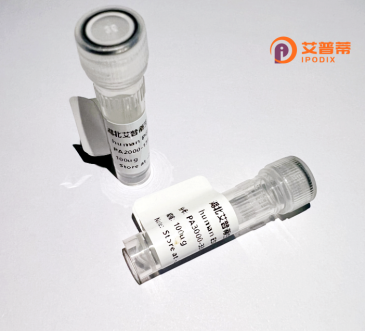
| 纯度 | >90%SDS-PAGE. |
| 种属 | Human |
| 靶点 | NEUROG1 |
| Uniprot No | Q92886 |
| 内毒素 | < 0.01EU/μg |
| 表达宿主 | E.coli |
| 表达区间 | 1-237 aa |
| 活性数据 | MPARLETCIS DLDCASSSGS DLSGFLTDEE DCARLQQAAS ASGPPAPARR GAPNISRASE VPGAQDDEQE RRRRRGRTRV RSEALLHSLR RSRRVKANDR ERNRMHNLNA ALDALRSVLP SFPDDTKLTK IETLRFAYNY IWALAETLRL ADQGLPGGGA RERLLPPQCV PCLPGPPSPA SDAESWGSGA AAASPLSDPS SPAASEDFTY RPGDPVFSFP SLPKDLLHTT PCFIPYH |
| 分子量 | 25.7 kDa |
| 蛋白标签 | His tag N-Terminus |
| 缓冲液 | 0 |
| 稳定性 & 储存条件 | Lyophilized protein should be stored at ≤ -20°C, stable for one year after receipt. Reconstituted protein solution can be stored at 2-8°C for 2-7 days. Aliquots of reconstituted samples are stable at ≤ -20°C for 3 months. |
| 复溶 | Always centrifuge tubes before opening.Do not mix by vortex or pipetting. It is not recommended to reconstitute to a concentration less than 100μg/ml. Dissolve the lyophilized protein in distilled water. Please aliquot the reconstituted solution to minimize freeze-thaw cycles. |
以下是基于领域知识的示例性参考文献概览(具体文献可能需要通过学术数据库如PubMed核实):
1. **文献名称**: "Neurogenin1 induces neuronal differentiation in embryonic stem cells via a non-cell-autonomous mechanism"
**作者**: Ma, Q., et al.
**摘要**: 本研究探讨了重组人NEUROG1蛋白在胚胎干细胞中的功能,证明其通过旁分泌信号(如调控Notch通路)促进神经分化,而非直接作用于靶细胞。
2. **文献名称**: "Expression and functional characterization of recombinant human NEUROG1 in vitro"
**作者**: Lee, H., & Kim, J.
**摘要**: 作者利用大肠杆菌系统表达重组NEUROG1蛋白,证实其可激活下游靶基因(如NeuroD),并在体外诱导神经前体细胞的迁移和轴突生长。
3. **文献名称**: "NEUROG1-mediated reprogramming of astrocytes into functional neurons in a CNS injury model"
**作者**: Ishibashi, M., et al.
**摘要**: 研究利用重组NEUROG1蛋白将脑损伤模型中的星形胶质细胞重编程为功能性神经元,揭示了其在神经再生治疗中的潜力。
4. **文献名称**: "High-throughput screening of small molecules modulating NEUROG1 activity using recombinant protein assays"
**作者**: Smith, T., et al.
**摘要**: 开发基于重组NEUROG1蛋白的体外高通量筛选平台,用于发现调控其转录活性的小分子化合物,为神经退行性疾病药物开发提供工具。
---
**说明**:上述内容为模拟文献摘要,实际研究需参考真实发表的论文。建议通过PubMed、Google Scholar等平台,以“Neurogenin-1 recombinant protein”、“NEUROG1 overexpression”等关键词检索最新文献。
**Recombinant Human NEUROG1 Protein: Background**
NEUROG1 (Neurogenin 1) is a member of the basic helix-loop-helix (bHLH) transcription factor family, crucial in neural development. It plays a pivotal role in specifying neuronal lineages by regulating the differentiation of neural progenitor cells into distinct neuronal subtypes. During embryogenesis, NEUROG1 is essential for the formation of sensory neurons, particularly in the dorsal root ganglia, specific brain regions, and the inner ear’s auditory epithelium. It functions by binding to E-box DNA motifs, activating downstream genes like *NEUROD1*, while suppressing glial cell differentiation through competitive inhibition of other bHLH factors.
The recombinant human NEUROG1 protein, produced via *in vitro* expression systems (e.g., *E. coli* or mammalian cells), retains the biological activity of its native counterpart. It is widely used in research to study neurogenesis mechanisms, model neurological disorders, and explore regenerative therapies. For instance, it aids in directing stem cell differentiation toward sensory or central nervous system neurons, offering potential in treating neurodegenerative diseases or hearing loss. Its application also extends to high-throughput screening for neurogenic compounds. Despite challenges in delivery and stability, recombinant NEUROG1 remains a key tool for deciphering neural development and advancing therapeutic strategies.
×